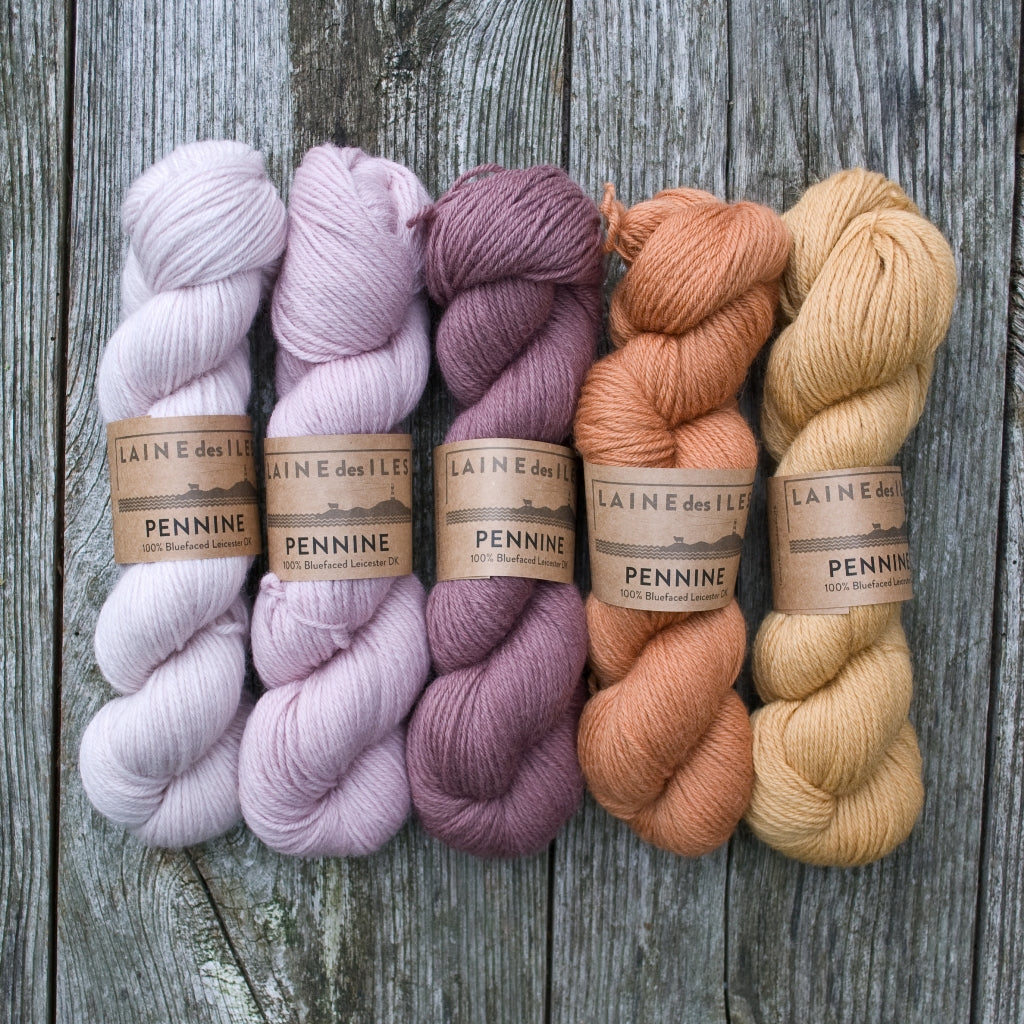We are proud to present our very first own-label yarn. Pennine DK is a beautiful, soft yarn spun entirely from the fleeces of Bluefaced Leicester sheep. The Bluefaced Leicester is one of the best-known and most recognizable of British breeds, with its Roman nose and long ears. The breed was originally developed in the 19th century in the English county of Northumberland, at the northernmost tip of the Pennines, a chain of hills and mountains that is known as the backbone of England.
The Bluefaced Leicester is a longwool breed, producing particularly fine and soft wool (typically 24-28 microns) which is also strong, silky and lustrous. It is one of the most luxurious of all British breeds, often referred to as the British merino due the wonderful softness and quality of its wool. It rivals pure merino wool for its softness, but for a much more reasonable price. Pennine DK is a smooth and uniform yarn, which gives excellent stitch definition and drape.
Pennine DK has been spun exclusively for Laine des Iles by West Yorkshire Spinners, and dyed for us by a specialist dyer using only sustainable GOTS certified dyes in a small palette of tonal grays, blues and pinks, with 3 accent colors.
![[english]](http://cdn.shopify.com/s/files/1/0977/1950/files/Blueface_1_Medium_large.jpg?v=1599898665)
The origins of the Bluefaced Leicester sheep breed date back to the 18th century when breeder Robert Bakewell developed a scheme designed to improve the older longwool breeds, which produced good fleece, but poor meat and few lambs. During the Middle Ages, the focus in England had been more on wool than meat, but by the 18th century this had changed. Bakewell was considered to be a genius livestock breeder, known for his work with horses, cattle and especially sheep. His aim was to produce a breed that would keep the fine fleece, but give better gains for meat.
During the 1750’s, Bakewell developed a sheep which became known as the Dishley Leicester (named after his home, Dishley Grange), which was a faster-maturing animal with better quality meat, but most significantly a superior ability to create high-quality crossbreeds. Bakewell had the idea of leasing his rams out to farmers who were willing to pay, and it was not long before the Dishley Leicester became popular all over Britain. This system also allowed Bakewell to see how other breeds performed when crossed with his rams, and thereby to further develop improved crossbreeds.
He also acquired a number of followers and students keen to learn his breeding methods. Two of these were the Culley brothers in Northumberland who used the Dishley Leicester in their own breeding program to create the Border Leicester - a beautiful breed with a lustrous fleece, famous for its “rabbit ears”, which is still popular today. The Bluefaced Leicester breed as we know it today was developed in Northumberland from the Border Leicester, and was first recognized as a distinct breed in the late 19th century.
The Bluefaced Leicester was originally created as crossing breed, and in the United Kingdom this is still its primary purpose today, with its sought-after wool a welcome secondary benefit. When a Bluefaced Leicester ram is crossed with another breed (usually a hardy hill breed such as the Scottish Blackface, Welsh Mountain or Cheviot), the ewes that are produced are called Mules. These ewes are considered to be the backbone of British sheep farming, as they will lamb in their first year, often with twins, and are excellent mothers. Therefore although the Bluefaced Leicester is not in itself bred primarily for meat, it is one of the most valuable breeds in British sheep farming due to this remarkable crossing ability. Bluefaced Leicester rams produce around 50% of British commercial ewes and so have significant economic value.
Like its ancestors, the Bluefaced Leicester is classified as a longwool sheep. As the name suggests, longwool sheep produce a fleece with very long fibers, usually with a large diameter (32 to 40 microns). This makes their wool very strong, hardwearing and lustrous. The Bluefaced Leicester however produces a fleece with long, narrow, curly locks which is much thinner than that of other longwool breeds (between 24 and 28 microns). As a result it is also much softer and silkier, and when spun gives a yarn that is not only strong, but also very soft with a beautiful drape and soft luster. Although a very different wool to merino, it is also soft enough to wear next to the skin, but is considerably more reasonably priced. It can be used as an alternative in patterns calling for other more expensive DK yarns such as Brooklyn Tweed Arbor and Westwool Tandem.
Over the next few months we will be presenting several new patterns for Pennine, the first should be published in just a few weeks. So keep your eye out for new kits and new ideas for our new own-brand yarn!




Waouh !!!!!j adooore votre reportage, surtout dans l avenir découvrir vos magnifiques laines belle journée
Au plaisir
Amicalement
Je retricoterai vos gris dont l’histoire me fascine, félicitation pour votre documentation, votre talent narratif, l’avenir vous appartient !
Leave a comment